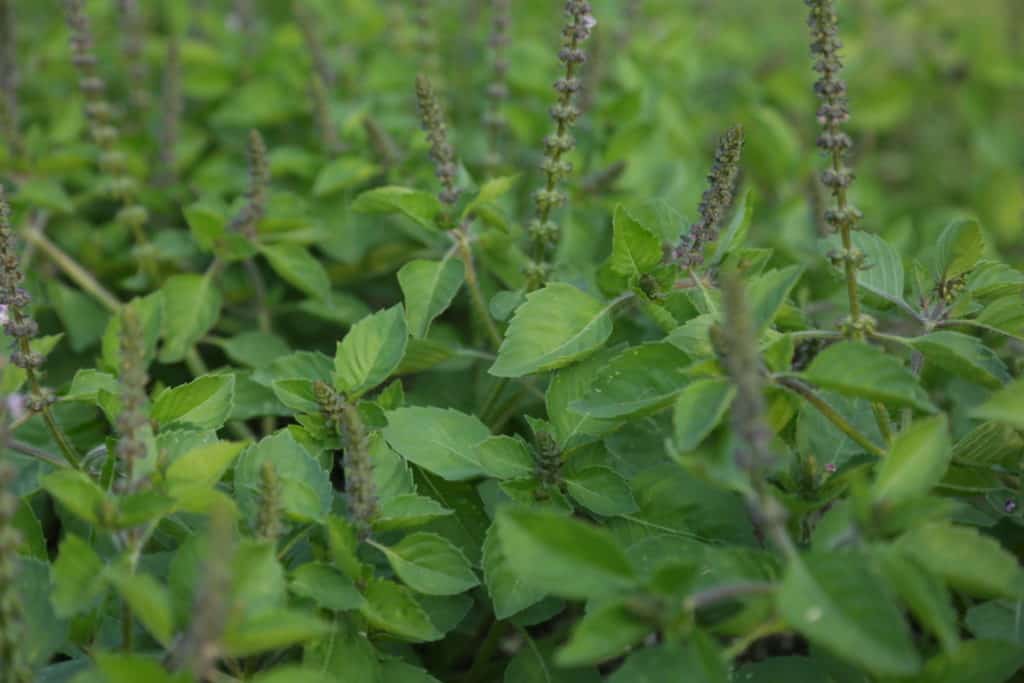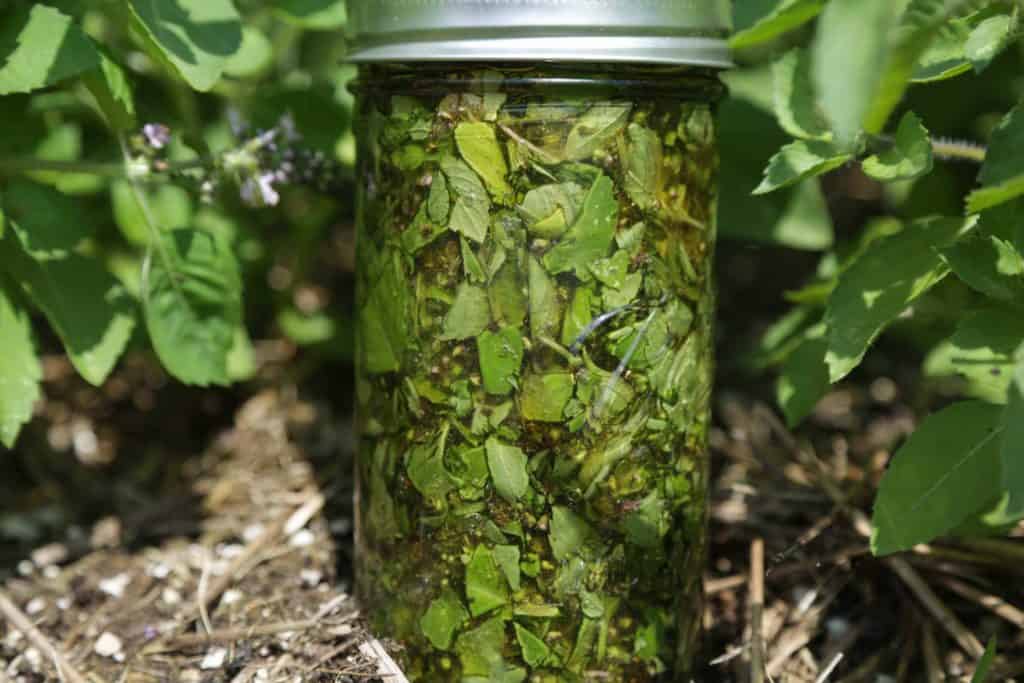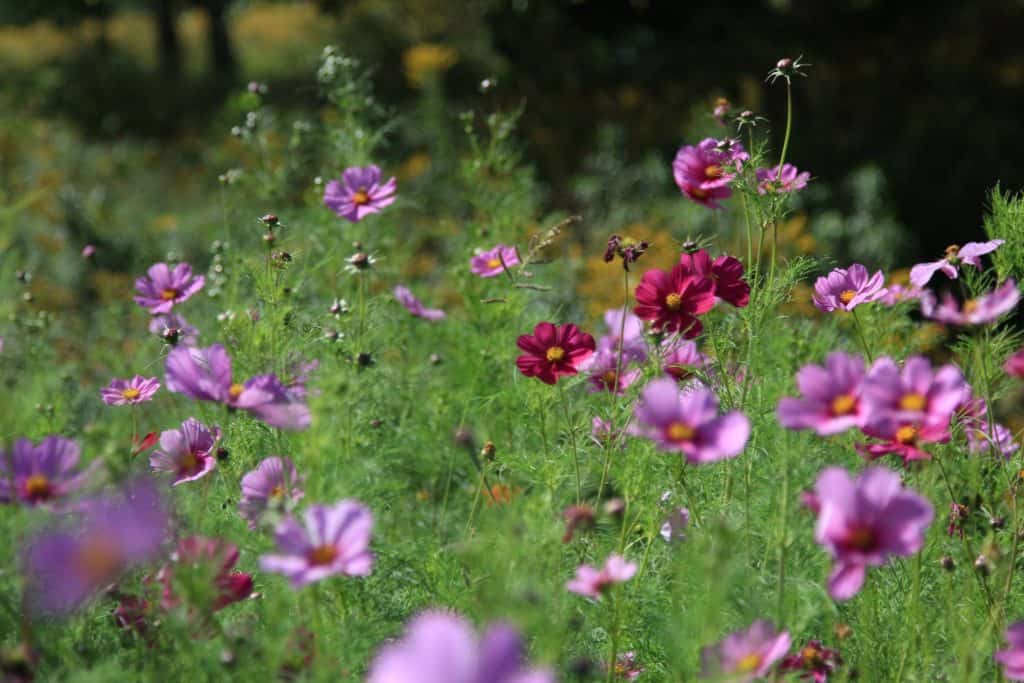Honey, Tulsi & the Sweetness of Summer
It’s the harvest time of year and I’m sure you’re all out like the bees, buzzing around the flowers and harvesting whatever’s ripe. One of my favorite ways to preserve some of the harvest is in honey and my all time favorite infused honey is Tulsi or Sacred Basil.
This article has two recipes, and you’ll learn how to make an infused oil with both fresh plant material and powders – but first a little more about this beautiful plant.
Tulsi, Ocimun sanctum, is named after the Hindu goddess who chose to be reincarnated as a sacramental herb to express devotion to the god, Vishnu. Everything associated with the Tulsi plant is considered sacred, the soil, air and the water nourishing her. Traveling in India, or visiting people “in the know here in the U.S.”, you will find Sacred Basil plants outside of people’s homes. Tulsi gives the protection of the divine from birth to death and opens the heart and mind. Mala beads are made from Tulsi stalks. All these gifts in exchange for caring for this beautiful aromatic plant.
On the physical side, Tulsi is :
- uplifting to the spirit (ok, to the nervous system if you must)
- healthy for the body (reduces stress and increases the immune system)
- is considered an adaptogenic, (long-life herb…you may know the ginsengs, siberian or american who also fall into this category) by increasing metabolic oxygenation (endurance) and improving digestion.
All this and she tastes delicious!
I’m imagining your tulsi (or your friend’s) is ready for the first harvest (we usually get two cuttings per year), so here’s my simple recipe for tulsi honey.
The Recipe
It’s so simple and so delicious. It makes a lovely gift of instant gustatory bliss. Ready for the recipe? Let’s pretend we are only making one quart.
Harvest fresh tulsi leaf and flower.
- Chop it up as fine as you like.
- Place in jar.
- Pour honey over the top (add a little and stir to mix with the plant material). You’re looking to just cover the plant material with honey.
- *Place on a sunny window sill where you’ll see it every day and it will get warmed a little by the sun’s kiss.
- Shake, pray & flip every day.
- After about a week, taste daily to wait for the peak flavor. When you’ve found the sweet spot (pun intended), strain the honey and squeeze out as much of the honey as you can from the plant material.
- I like to leave the honey soaked plant material outside on some rocks for the resident bees. They will clean it dry.
- Too much water from the plants in the mixture could cause mold. One way to prevent mold is to place in a water bath with an open lid for 1-2 hours to let the water vapor escape at the end of the process when the honey is filtered.
*You could speed up the process by putting the infusing honey in a hot water bath (130-140 degrees Fahrenheit) for up to 3-4 hours. Be sure to leave the lid off so water vapor from the plant can escape.).
What to do with the infused honey?
Use it like you would your uninfused honey. Put it on toast, add it to tea, or make an instant tulsi tea by placing a spoonful in hot water. Give it to your loved ones.
Wait! Where do I get my honey?
The best place is to find your honey is with a local beekeeper, who, by the way, is absolutely in love with her/his bees. Ask about their bees, their practice….they will love to chat with you. Order a larger quantity than the smaller jars they sell at the farmer’s market (I usually make 1 gallon of the Tulsi honey alone.). Get to know your local people, listen to their stories, support them to care for the bees we all need.
The sky’s the limit.
You are not limited to the recipe above for infusing honey. What calls you? Lemon balm? Rose? Linden flower? If you’re not sure, make just a little.
Another way to make a powerful medicine is to infuse powders into the honey. This is an old and widely used method of medicine making, especially in places and times where alcohol is not readily available or desired. The difference between this medicine and the infusion from above, is you are making an herbal suspension. Powder is added and left in the honey, rather than straining it out.
My first introduction to honey powders was with my first herbal teacher, Rosemary Gladstar. She gave recipes for suspending adaptogenic herbs in honey to make a paste for daily consumption. It is a nice way to get a larger quantity of not-so-great-tasting-herbs into the body every day.
My second go round with honey powders was with Lisa Ganora, of the Colorado School of Clinical Herbalism. I’d been looking for ways to get Turmeric in on a regular basis at a level to decrease inflammation. This therapeutic dose is not palatable in an infusion or tincture, and you can’t eat enough in a day when you’re dealing with chronic inflammation.
So enter Lisa and her recipe for Turmeric, Ginger, Black Pepper honey.
Lisa’s Turmeric, Ginger & Black Pepper Honey Recipe
The process of making a suspension of powder in honey is more labor intensive and well worth the effort. It requires heating the the honey in a double boiler (or mason jar in a water bath) and slowly adding the powders.
Please know the basics of the recipe are here, but this is really to grab your attention so you’ll be interested enough to go and research on your own the whole process. Or if you’re like me, you’ll take the basics and give it a try.
Premix powder in a jar. Ratio of powders is 1 part Ginger: 1 part Black Pepper: 8 parts Turmeric. For the sake of ease, let’s say 1 TBS each.
- Ratio of honey to powder to start: 1 TBS powder: 1 fl.oz honey.
- So, 10 fluid ounces of honey in mason jar in water bath. The ideal temperature to get “runny honey” is 130-140 degrees fahrenheit.
- SLOWLY add the powder and stir the entire time. (1 tablespoon at a time).
- Remember the honey is more runny when warm and will thicken as it cools. You are hoping for a finished product you can spoon out of the jar every day.
- The dose is 1 teaspoon-1 tablespoon/day.
Why these herbs with honey?
Turmeric is all over the interwebs and journals as being the anti-inflammatory superstar and also helps the liver detoxify. Ginger is anti-inflammatory & detoxifying for the liver as well. Black pepper is added to the recipe because it facilitates the absorption of the curcuminoid constituents in the ginger and turmeric across the small intestine lining. All of the herbs are heating & drying. The honey helps to bring cooling & moisture to the medicine.
Wait! Doesn’t heating denature the honey?
Yes, heating the honey to it’s “runny” consistency does denature the enzymes in honey. AAANND the enzymes you are hoping to preserve are necessary when using the honey topically as an antibacterial agent. I don’t suggest putting this powder on an open wound. Ouch!! For our medicinal purposes with the honey, heating to this temperature is not an issue.
Go give it a try!
The harvest season can sometimes overwhelm us as we gather nature’s bountiful gifts. It’s fun to diversify the way we preserve the harvest. Drying and tincturing Tulsi is what most of us do to preserve and be able to use this medicine over the winter months. I encourage you to try and make even just a little infused honey to add to your home apothecary. Chances are you’ll find you didn’t make enough. That’s ok, there’s always next year.




